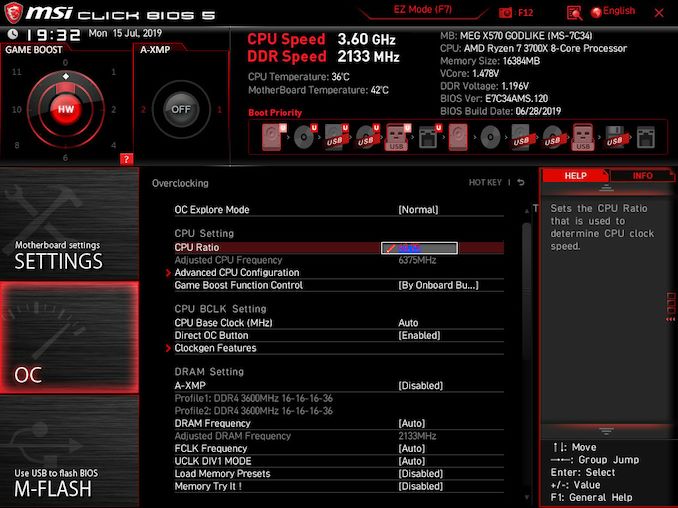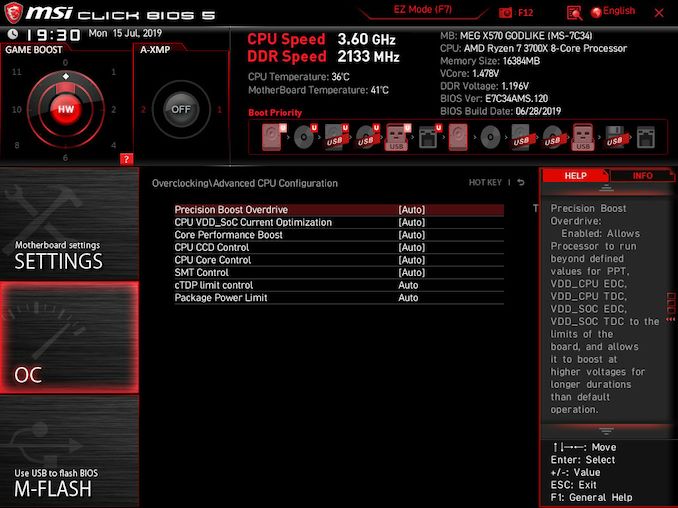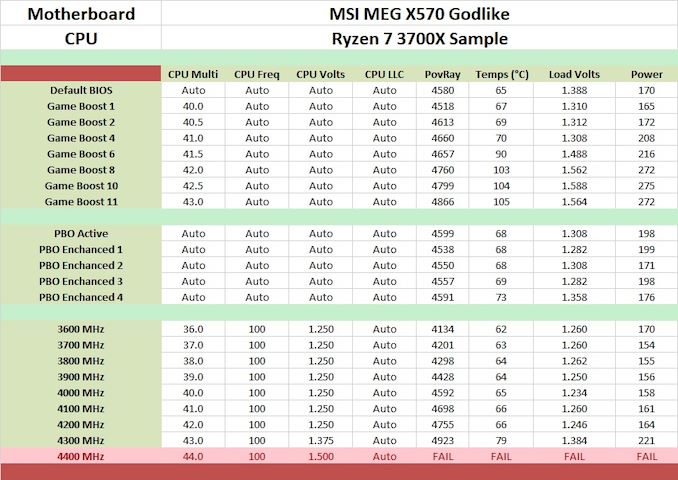The MSI MEG X570 Godlike Motherboard Review: Thor's Flagship
by Gavin Bonshor on August 28, 2019 12:00 PM EST- Posted in
- Motherboards
- AMD
- MSI
- 10G Ethernet
- Ryzen
- PCIe 4.0
- Ryzen 3000
- X570
- X570 Godlike
- MEG
Overclocking Ryzen 3000
Experience with the MSI MEG X570 Godlike
Overclocking with the Ryzen 3000 series hasn't exactly titillated users since its launch with there not being much headroom available. The biggest issue with this boils down to all-core overclocks being limited by the worst core of the chip. and the new 7 nm processors running quite warm. To get the best experience and results with the Ryzen 3000, users with good quality AIOs and custom water cooling yields the best outcome, and even with voltages of 1.375 V, these chips can run a little too warm for comfort.
The MSI Click BIOS 5 firmware is familiar to us and throughout the different chipsets including X399, X470, and Z390, the MSI MEG X570 Godlike uses the same design layout and setup. Within the OC section of the firmware, users can alter important settings such as the CPU ratio which can be changed in steps of 0.25 MHz, with relevant settings including CPU VCore, CPU Base Clock, and even FCLK frequency. Deeper into the firmware is settings to set the load line calibration (LLC) to a more aggressive or liberal profile, as well as all the Precision Boost Overdrive (PBO) settings.
The three main settings that PBO works from include package power tracking (PPT), thermal design current (TDC), and the electrical design current (EDC). All three of these can be set within the firmware under the advanced section of the Precision Boost Overdrive menu, although MSI has included four different PBO profiles for users to select from. The higher the setting, the higher the thermal and power draw will be, and it may not necessarily matter if a sub-par cooler is installed; it's noted that Ryzen 3000 processors work better when they are cooler.
There are seven different MSI Game Boost profiles to select from and users can access them via the dial at the bottom of the board, or through the firmware itself. The Game Boost profiles within the firmware can be accessed through the dial in the top left-hand corner. These profiles range from 4.0 GHz through to 4.3 GHz, and we've tested each of them below.
Overclocking Methodology
Our standard overclocking methodology is as follows. We select the automatic overclock options and test for stability with POV-Ray and OCCT to simulate high-end workloads. These stability tests aim to catch any immediate causes for memory or CPU errors.
For manual overclocks, based on the information gathered from the previous testing, starts off at a nominal voltage and CPU multiplier, and the multiplier is increased until the stability tests are failed. The CPU voltage is increased gradually until the stability tests are passed, and the process repeated until the motherboard reduces the multiplier automatically (due to safety protocol) or the CPU temperature reaches a stupidly high level (105ºC+). Our testbed is not in a case, which should push overclocks higher with fresher (cooler) air.
Overclocking Results
As it currently stands, MSI's Game Boost overclocking profiles need quite a bit of refinement, something they have informed us that these will be rectified with a new firmware revision; we will test this when we receive the board back from MSI. The issue with these is CPU VCore, or in a nutshell, too much of it which cross the board into the unsafe territory of the Ryzen 3000 processors safety limits; both in CPU VCore and in temperature. When we activated PBO and MSI's preset profiles for this, it didn't make much of an impact over the stock settings, which seems to be a reoccurring issue so far across the range of models we have tested so far.
Manually overclocking the MSI MEG X570 Godlike proved very fruitful and we managed to hit what seems to be the limits of our Ryzen 7 3700X testbed CPU with an overclock of 4.3 GHz all-cores with a CPU VCore of 1.35 V, which seems to be the brick wall for our processor. Even with a CPU VCore of 1.50 V, we couldn't get 4.4 GHz to remain stable when any kind of semi-intensive load was placed on the processor, although we did manage to boot into Windows 10 without fanfare with these settings. The performance wasn't throttled in POV-Ray throughout each of the frequencies tested and once the temperature limit of 110ºC is exceeded, the system will safely shut down. From 3.6 to 4.2 GHz, we managed to do this with a set CPU VCore of 1.250 V which did fluctuate slightly under load under the auto LLC setting. It is safe to say that the MSI MEG X570 Godlike doesn't have a VDroop issue and even at 4.3 GHz, a set CPU VCore of 1.375 resulted in a maximum load voltage of 1.384 V which isn't too far off the mark.













116 Comments
View All Comments
WaltC - Thursday, August 29, 2019 - link
Not to mention an old architecture Intel's been milking for years that is full of security holes and software & bios patches, etc. Nah, the longevity argument and bang-for-the-buck argument is won by AMD this time, decisively.Oliseo - Thursday, August 29, 2019 - link
"Not to mention an old architecture Intel's been milking for years that is full of security holes and software & bios patches, etc. Nah, the longevity argument and bang-for-the-buck argument is won by AMD this time, decisively."Be careful of comments like this. They may come back to haunt you. Just because there seems to be no security issues in AMD does not mean they don't exist.
After all, it's not like you were screaming about spectre a couple of years ago, was you.
Oxford Guy - Thursday, August 29, 2019 - link
Reality is that people buy what's available today. Today, there are more security problems with Intel than with AMD.Today, Intel has a worse track record for security robustness.
However, I will say that both companies embed black boxes into their chips. AMD stripped PSP for China, presumably to add a different black box.
29a - Friday, August 30, 2019 - link
Is the next Ryzen using the same socket?Qasar - Friday, August 30, 2019 - link
given AMD's track record for upgrade ability, its quite possible, it could.Threska - Saturday, August 31, 2019 - link
Future Proofing? So that means we've finally gotten something definite about 2020 forward on socket AM4, and PCI 5.Peter2k - Thursday, August 29, 2019 - link
Or buy a solid X570 for way less and still get an all core of 4.2The difference you achieve with pricier boards is negliable really, AMD or Intel
Also I have no idea why you're bashing and then referring to Intel in this regard, you can easily buy a 700$, or even 1000$ Z390
Sweetbabyjays - Thursday, August 29, 2019 - link
"get an all core of 4.2" according to silicon lottery's statistics, only the top 21% of their 3700x cpu's tested could get to 4.15GHz (all core). So to get a guaranteed 4.2 you need to get a 3800x.I agree that the difference with pricier boards is negligible, really your silicon is more determinate of your max OC than your motherboard.
The reason I'm bashing (this $700 motherboard specifically) is because if you're willing to dump $700 on a motherboard in the pursuit of performance you can literally pay that $700 for a cpu and motherboard combo(the 9900k and a Z390 board) that destroys the performance of the 3700x (the one tested in the article) and any motherboard.
If you compare product level to product level you will find that the X570 price vs Z390 version of say the Gigabyte AORUS XTREME or the MSI MEG Godlike, is ~ $150 and $100 respectively more expensive for the X570 version.
If you need an 8c/16t cpu and you're after the highest performance overclocked option, why pay more for a 3700x/X570 for less performance than a 9900k/Z390?
AshlayW - Thursday, August 29, 2019 - link
Dude where are you getting that 3700X/X570 costs more than 9900K/Z390? The CPU alone is like 150 bucks cheaper, and decent X570s are around 150-200 bucks, the same as decent Z390s. You also have to buy the cooler for the Blast Furnace 9900K to get it anywhere near those "4.8GHz" clocks you're going to need another 50 bucks on a cooler, whereas the 3700X can use its included Prism easily. By your own admission "5-10%" performance isn't worth it, so why pay 150-200 bucks more for a less efficient, dead-end, security vulnerability ridden product based on tech from 2015, when you can have 90% its performance with the latest features including PCIE4.0, for less money?I'm sorry mate but you're not making sense or you're delusional. Please don't spread misinformation, and I suggest people go to their favourite retailer/store and check prices if they want to confirm it themselves.
Sweetbabyjays - Thursday, August 29, 2019 - link
Ashlay you need to cool your jets broseph.The first section of my comment is referring to how pointless this $700 board is when you can spend that $700 and get a Z390 and 9900k that will beat the cpu tested in the article (3700x) on this monstrosity of a board.
Then I commented how X570 in general has an inflated cost that really hurts the value proposition of the Ryzen CPUs when you compare model tier to model tier.
As per PC Partpicker:(my source wasn't mentioned, so sorry for not saying that)
MSI X570 Godlike $689.99
MSI Z390 Godlike $578.86
Difference: ~$111
Gigabyte X570 AORUS XTREME $706.98
Gigabyte Z390 AORUS XTREME $549.99
Difference: ~$150
To get the 9900k to 4.8 is really very little effort at all and most can go there with 1.25V which again is pretty tame and hardly creates the "furnace" you're talking about. Yes at 5.1 GHz and say 1.4V the 9900k is probably excellent for tempering swords and casting iron. The 3700x can use it's stock cooler easily, at stock speeds, I totally agree, but once you get that overclock going, you are going to need a better cooler, note the temps above are with 240mm AIO on the 3700x.
I'm not going to argue with the efficiency, because AMD did quite well in that regard with their 7nm process, it clearly is more power efficient.
As far as security issues they have both had their own issues over the years, although Intel has had a fair amount more.
I think though you really hammer the point i am making home with your statement "...product based on tech from 2015, when you can have 90% its performance..."
Intel tech from 2015 is still 10% better performing than AMD's best and newest tech in 2019.
Then you say in another comment "they've won the performance and value games both at once." i never knew 10% less performance is better.
As for PCIE 4.0 if AMD has big Navi coming that can actually outperform a PCIE 3.0 x16 slot's bandwidth then I will be the first in line to get a 3900x and x570. But until there is a single card that is limited by PCIE x16 I personally don't see any reason for it. Sure ridiculously fast nvme drives are nice, but again, they don't do a whole lot to improve gaming or most workflows.